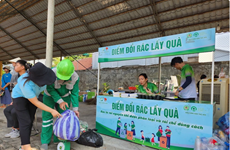Hong River flow vital for northern region: expert
Many parts of Hong (Red) and Thai Binh rivers in the north have seen
its average water level remarkably reduced - by two metres lower than
the previous 20 years.
Many parts of Hong (Red) and Thai Binh rivers in the north have seen
its average water level remarkably reduced - by two metres lower than
the previous 20 years.
This has caused massive drought on hundreds of thousands of hectares of farmland, blocked waterway transport and seriously polluted the rivers, a conference heard on February 11.
At the conference on management of the Hong-Thai Binh river system, PhD Rodolfo Soncini-Sessa of the Technical University of Milan said that the flow of the Hong River must reach about 1,200 cubic metres per second to supply enough water for the Red River delta.
However, in the past several years, the flow fell to 900 cubic metres per second.
"It is vital to keep the water level of 2.3 metres high in Hanoi's Long Bien district to ensure the supply of water for the city," he said.
The River covers Hanoi and 25 other provinces in the north with a population of 26 million people and total agricultural area of nearly 1.1 million hectares.
In terms of waterway transport, he said the minimum of the water level in the area around Long Bien Bridge must be 1.1 metres, but many vehicles were banned to operate as it was down to under 0.4 metres sometimes.
According to the Italian expert, the decrease of water level at pumping stations in lower section of the river and the construction of hydro-power plants have affected the flow.
Since 1960, Vietnam have spent more than 500 million USD to curb the changes of flow in the Red River, but the effectiveness remains limited.
A 2.2 million USD project, which has been implemented in Vietnam since 2012, will help improve study on the flow allocation of the two rivers, maintain essential ecological services and improve the economic benefits of hydro-power production and agriculture, he said.
The project has managed to specify 24 indexes on exploiting the river water in five sectors and the shortage of electrical energy of hydro-power plants in dry seasons.
It is being funded by the Italian Ministry of Foreign Affairs, the Technical University of Milan and the Institute of Water Resources Planning under the Ministry of Agriculture and Rural Development.
Bui Quang Tuan, representative of the Institute of Water Resources Planning, said the irrigation system has downgraded as many pumping machines were built more than 50 years ago and reached about 70 percent of their performance.
Moreover, the encroachment of the river and the discharge of waste water from industrial zones and residential areas have made it seriously polluted, he said.
Deputy Minister of Agriculture and Rural Development Hoang Van Thang said the ministry has carried out a programme on improving the irrigation system with the estimated investment capital of 20 trillion VND (940 million USD) until 2020.
The programme will supply more water from reservoirs in Hoa Binh, Thac Ba, Tuyen Quang and Son La. A series of irrigation works, such as Trung Ha, Bach Hac, Dai Dinh, Thanh Diem, Dan Hoai, Xuan Quan and Long Tuu, and a system of dykes will be built and upgraded.
As many as 129 pumping stations and 14 culverts will be built, and more than 230 pumping stations and 14 culverts upgraded under this programme, he said.-VNA
This has caused massive drought on hundreds of thousands of hectares of farmland, blocked waterway transport and seriously polluted the rivers, a conference heard on February 11.
At the conference on management of the Hong-Thai Binh river system, PhD Rodolfo Soncini-Sessa of the Technical University of Milan said that the flow of the Hong River must reach about 1,200 cubic metres per second to supply enough water for the Red River delta.
However, in the past several years, the flow fell to 900 cubic metres per second.
"It is vital to keep the water level of 2.3 metres high in Hanoi's Long Bien district to ensure the supply of water for the city," he said.
The River covers Hanoi and 25 other provinces in the north with a population of 26 million people and total agricultural area of nearly 1.1 million hectares.
In terms of waterway transport, he said the minimum of the water level in the area around Long Bien Bridge must be 1.1 metres, but many vehicles were banned to operate as it was down to under 0.4 metres sometimes.
According to the Italian expert, the decrease of water level at pumping stations in lower section of the river and the construction of hydro-power plants have affected the flow.
Since 1960, Vietnam have spent more than 500 million USD to curb the changes of flow in the Red River, but the effectiveness remains limited.
A 2.2 million USD project, which has been implemented in Vietnam since 2012, will help improve study on the flow allocation of the two rivers, maintain essential ecological services and improve the economic benefits of hydro-power production and agriculture, he said.
The project has managed to specify 24 indexes on exploiting the river water in five sectors and the shortage of electrical energy of hydro-power plants in dry seasons.
It is being funded by the Italian Ministry of Foreign Affairs, the Technical University of Milan and the Institute of Water Resources Planning under the Ministry of Agriculture and Rural Development.
Bui Quang Tuan, representative of the Institute of Water Resources Planning, said the irrigation system has downgraded as many pumping machines were built more than 50 years ago and reached about 70 percent of their performance.
Moreover, the encroachment of the river and the discharge of waste water from industrial zones and residential areas have made it seriously polluted, he said.
Deputy Minister of Agriculture and Rural Development Hoang Van Thang said the ministry has carried out a programme on improving the irrigation system with the estimated investment capital of 20 trillion VND (940 million USD) until 2020.
The programme will supply more water from reservoirs in Hoa Binh, Thac Ba, Tuyen Quang and Son La. A series of irrigation works, such as Trung Ha, Bach Hac, Dai Dinh, Thanh Diem, Dan Hoai, Xuan Quan and Long Tuu, and a system of dykes will be built and upgraded.
As many as 129 pumping stations and 14 culverts will be built, and more than 230 pumping stations and 14 culverts upgraded under this programme, he said.-VNA













